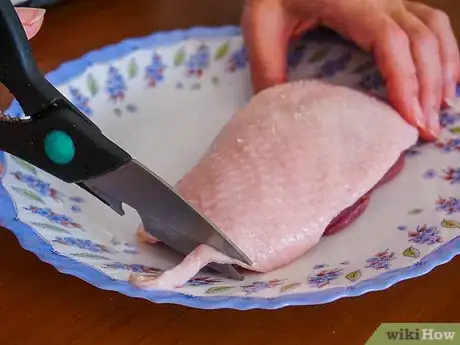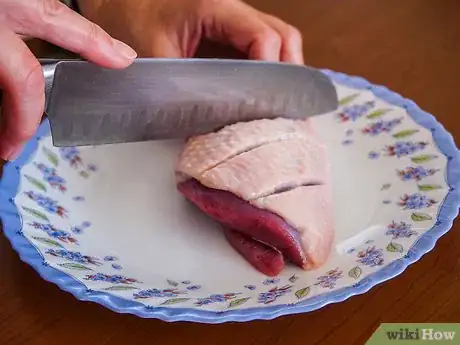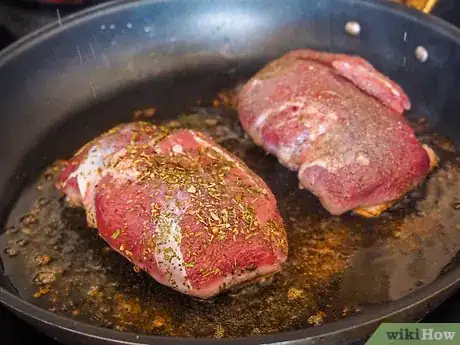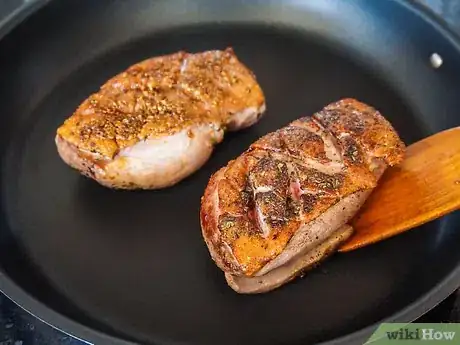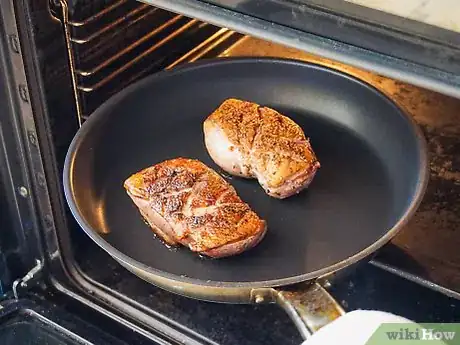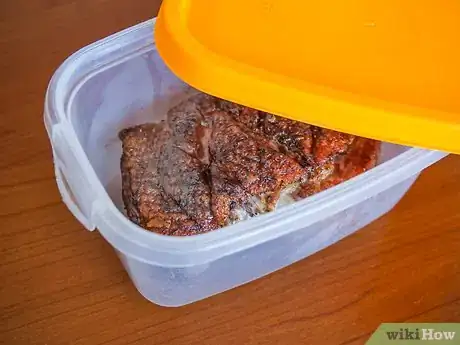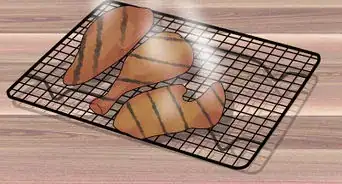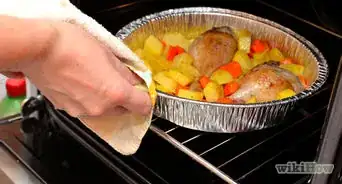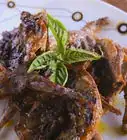This article was co-authored by Ollie George Cigliano. Ollie George Cigliano is a Private Chef, Food Educator, and Owner of Ollie George Cooks, based in Long Beach, California. With over 20 years of experience, she specializes in utilizing fresh, fun ingredients and mixing traditional and innovative cooking techniques. Ollie George holds a BA in Comparative Literature from The University of California, Berkeley, and a Nutrition and Healthy Living Certificate from eCornell University.
This article has been viewed 19,898 times.
Duck breast is an easy and delicious meal! The breasts only take about 10 minutes to prepare and 15 minutes to cook. Eat the breasts alone as a tasty snack or serve them with a fruit sauce and your favourite vegetables. This method is the most popular way of cooking duck breast as it keeps it moist as well as making the skin crispy.
Ingredients
- 2 teaspoons ground coriander
- 2 teaspoons coarse salt
- 4 6 ounces (170 g) duck breasts
- Your favorite fruit sauce
Serves 4
Steps
Preparing the Duck Skin
-
1Preheat your oven to 400 °F (204 °C). Turn your oven to the bake setting and set it to 400 °F (204 °C). Place the oven rack in the middle shelf of the oven. This will help the duck breasts to cook evenly. Most ovens take at least 10 minutes to heat up.[1]
-
2Trim extra skin and fat off the breasts. Use a clean pair of scissors or a sharp knife to trim off any skin or fat that hangs off the sides of the breasts. Keep any skin and fat that sits on top of, or underneath the breasts.[2]
- Try not to cut into any of the duck breast when you are removing extra skin or fat. Don’t worry about trimming very small pieces of excess fat. It is better to leave small sections of fat or skin than it is to damage the meat.
Advertisement -
3Score the skin of the duck breasts in a crisscross pattern. Duck is a very fatty bird, and it is essential to score the skin to maximize deliciousness. Use a clean and sharp knife to make shallow cuts in the skin of the duck breast. Make 5 cuts in one direction across the width of the duck breast, try to create an even distance between the cuts. Turn the duck breast 90 degrees and create 5 more cuts to create a crisscross pattern.
- This allows the fat to be released while the duck cooks.
- Repeat this for each of the breasts.
- Try to only cut the skin, not the meat. If your cuts are penetrating the meat, use less pressure when making the slices.[3]
- If you prefer a little fat left on the breasts after cooking, just barely score the skin; to render more fat, score more deeply, taking care not to cut too deep and expose the flesh, as this will dry out the meat.
-
4Sprinkle the duck skin with salt and ground coriander. Measure 2 teaspoons of salt and 2 teaspoons of ground coriander. Sprinkle the seasonings evenly over the duck skin.
- Mix the seasonings in a bowl first, or add them one after another onto the skin of the duck.
- If you have a favourite herb or spice, sprinkle this over the skin as well. Rosemary, thyme or oregano would all work well.[4]
Searing the Duck
-
1Place the duck breasts skin-side down into a large ovenproof skillet. Spread the duck breasts evenly in the skillet so that they aren’t touching each other. If your skillet isn’t big enough for the breasts to sit evenly, or you are using a larger quantity of breasts, use 2 skillets.[5]
-
2Cook the duck on your cooktop over medium-high heat for 7 minutes. Place the skillet onto the element for 7 minutes or until the the skin has browned and is crispy. If the pan starts vigorously spitting fat, turn down the heat slightly.
- Don’t move the duck around in the pan, just let it sit while it cooks.
- Hot fat can burn skin so keep children away from the pan while the duck is cooking.
-
3Turn the breasts over and cook for another 1 minute. Use tongs or a spatula to turn each breast over. Do this gently to avoid hot fats splashing you. Once again, make sure the breasts are distributed evenly in the pan. Cook the breasts for a further 1 minute and then remove them from the heat.[6]
- If the meat isn’t browned after 1 minute, allow it to cook on the stove for a further minute.
-
4Remove the breasts from the pan and pour out the fat. Place each of the breasts onto a clean plate, using tongs or a spatula. Using oven mitts, pour the fat from the skillet into a disposable container. Transfer the breasts back into the skillet. Make sure that the breasts are evenly distributed in the skillet.[7]
- Never pour fat down the drain as this can block your pipes. Instead place the container of fat into the trash bin.[8]
Roasting and Serving the Duck
-
1Place the pan in the oven for 5 minutes. Transfer the skillet into the middle shelf of the oven. Leave the pan uncovered so that the duck skin goes crispy. If you don’t have an ovenproof skillet, transfer the breasts into an oven dish instead. After 5 minutes, remove the dish from the oven.[9]
- After 5 minutes your breasts will be medium-rare. If you prefer your meat to be well cooked, leave it in the oven for a few more minutes.
- Use an instant read thermometer to check that the middle of the duck has risen to a temperature of 165 °F (74 °C).[10]
- Use oven-mitts when transferring the hot skillet into the oven.
-
2Transfer the duck to a chopping board and let it rest for 5 minutes. Use tongs or a spatula to remove the duck from the skillet and place it onto a clean wooden chopping board. Allow the meat to rest for 5 minutes. This will help increase the flavours and make the breast easier to cut.
- If there are flies around, place a mesh food cover over the meat while it rests.[11]
-
3Slice the breast crosswise using a carving knife. If you don’t have a carving knife, use a regular sharp knife to slice the duck instead. Cut through the breast crosswise on a slight diagonal angle. Push the knife back and forth in a sawing motion to cut the meat, rather than pushing the knife downwards.[12]
- If you prefer thicker slices of meat, make your slices further apart.
-
4Serve the meat with your favourite sauce and vegetables. Fruit flavored sauces tend to compliment duck well. Consider serving the meat with a plum, orange, cherry or red currant sauce. Pour the sauce to the side of the plate and use it as a dipping sauce or drizzle it over the top of the breasts.[13]
- Plum sauce, and other duck sauces, can be purchased from a butchery or grocery store.
-
5Store leftover duck in the fridge for 3-4 days. Place the leftover duck into a airtight container and leave it in the fridge. Leftover duck can be a great addition to sandwiches and burgers. The duck can be eaten cold or reheated in the microwave or oven.[14]
- If you reheat the duck, make sure you heat it until it is hot to touch. This decreases the likelihood of food poisoning.
- If you don’t have a spare airtight container, place the duck into a bowl and form a tight seal over the dish using cling wrap.
Expert Q&A
-
QuestionCan you reuse duck fat after cooking?
 Ollie George CiglianoOllie George Cigliano is a Private Chef, Food Educator, and Owner of Ollie George Cooks, based in Long Beach, California. With over 20 years of experience, she specializes in utilizing fresh, fun ingredients and mixing traditional and innovative cooking techniques. Ollie George holds a BA in Comparative Literature from The University of California, Berkeley, and a Nutrition and Healthy Living Certificate from eCornell University.
Ollie George CiglianoOllie George Cigliano is a Private Chef, Food Educator, and Owner of Ollie George Cooks, based in Long Beach, California. With over 20 years of experience, she specializes in utilizing fresh, fun ingredients and mixing traditional and innovative cooking techniques. Ollie George holds a BA in Comparative Literature from The University of California, Berkeley, and a Nutrition and Healthy Living Certificate from eCornell University.
Private Chef & Food Educator Definitely! Throughout the cooking process, pour out excess rendered fat into a jar. Once the fat has cooled, store the jar in the refrigerator and use it for frying potatoes, a crispy egg sandwich, or in place of oil for a rich, decadent flavor.
Definitely! Throughout the cooking process, pour out excess rendered fat into a jar. Once the fat has cooled, store the jar in the refrigerator and use it for frying potatoes, a crispy egg sandwich, or in place of oil for a rich, decadent flavor.
Things You’ll Need
- Ovenproof skillet
- Tongs
- Spatula
- Plate
- Sharp knife
- Chopping board
- Small bowl
- Oven mitts
- Carving knife
References
- ↑ https://www.epicurious.com/recipes/food/views/roast-duck-breasts-with-pomegranate-chile-sauce-356341
- ↑ https://www.epicurious.com/recipes/food/views/roast-duck-breasts-with-pomegranate-chile-sauce-356341
- ↑ https://www.epicurious.com/recipes/food/views/roast-duck-breasts-with-pomegranate-chile-sauce-356341
- ↑ https://www.epicurious.com/recipes/food/views/roast-duck-breasts-with-pomegranate-chile-sauce-356341
- ↑ https://www.epicurious.com/recipes/food/views/roast-duck-breasts-with-pomegranate-chile-sauce-356341
- ↑ https://www.epicurious.com/recipes/food/views/roast-duck-breasts-with-pomegranate-chile-sauce-356341
- ↑ https://www.epicurious.com/recipes/food/views/roast-duck-breasts-with-pomegranate-chile-sauce-356341
- ↑ https://lifehacker.com/how-to-properly-dispose-of-grease-and-oil-1570863303?IR=T
- ↑ https://www.epicurious.com/recipes/food/views/roast-duck-breasts-with-pomegranate-chile-sauce-356341
About This Article
To cook perfect duck breast, start by making criss-cross cuts into the skin on the breast, which will help release the fat when it cooks. Then, sprinkle on some salt and ground coriander for seasoning. Once you’ve seasoned your duck, cook it skin-side down over a medium heat for 7 minutes before flipping them over and cooking for another minute. Transfer the breasts to an oven-proof dish and roast them at 400 degrees Fahrenheit for 5 minutes if you like your meat medium-rare. If you prefer it well done, leave it in for a few more minutes. For tips on how to serve your duck breast, keep reading!

